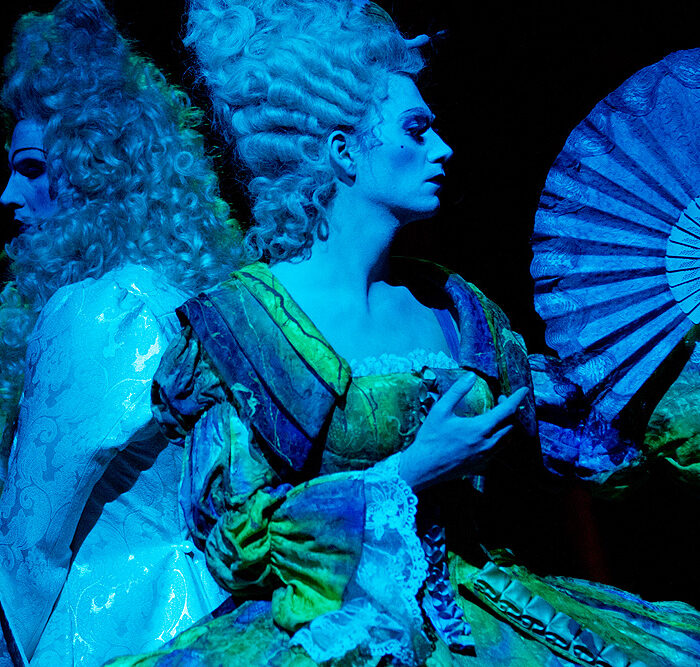
Opera Profile: Airat Ichmouratov’s ‘The Man Who Laughs’ & The Story Behind It
By John VandevertPhoto Credit: Airat Ichmouratov
Based on the seventh book by French novelist and poet Victor Hugo, Russian-Canadian composer Airat Ichmouratov and his opera, “The Man Who Laughs,” is a chilling look at the ways in which our pasts always catch up to us, no matter who we are, noble or otherwise.
The opera originated from a 2023 Festival Classica commission in Canada. On May 31 of this year, the opera had its formal premiere conducted by Ichmouratov himself. What’s fascinating about Ichmouratov is his experience with opera and composing, having a keen understanding of baroque and classical music while also having a solid knowledge of bel canto marvels. As a composer, he has created a large oeuvre of work already ranging from concertos and overtures to symphonies and quite a good amount of chamber music.
When it comes to opera, “The Man Who Laughs” is Ichmouratov’s first encounter as a composer. Yet, the influences on Ichmouratov speak to the sagacity by which he approaches the genre. Everyone from Mahler, Puccini, Beethoven and Strauss can be found among the opera’s musical influences. The libretto began taking shape two years ago in 2021, with a collaboration between the composer and librettist Bertrand Laverdure. This continued with a potential opera idea based around the figure of French novelist Honoré de Balzac.
The Story and Its Meaning
Opera plots focusing less on history and more on literary adaptations can sometimes be confusing. The meanings get lost on audiences who don’t necessarily understand the broader themes. Hugo’s novel deals with many complex topics interwoven within a sprawling narrative of courtly intrigue. The opera takes this source and deftly boils it down to the core emotional beats, delivering a punchy and cathartic experience even for an audience unfamiliar with Hugo’s works.
In Hugo’s novel, a homeless boy named Gwynplaine has been horribly disfigured, with the lower-half of his face permanently carved into a grotesque smile. One night the young Gwynplaine saves a blind girl called Dea from a snowstorm. The two of them are found by a traveling circus led by a man called Ursus. He takes pity on the two vagabonds exiled from society in different ways and employs them within his carnival.
As the novel progresses, the boy Gwynplaine grows into a young man. He is kind, competent, and handsome in all ways except for his terrible smile: which is all the rest of the world sees and what makes him the star attraction of the circus. Only Dea, who cannot see, recognizes what really matters. The two begin to fall in love. As the circus travels across 17th century England, Gwynplaine meets by chance and becomes obsessed with the Duchess Josiana. She is currently engaged to nobleman David Dirry-Moir, but has become jaded and seeks to venture beyond the walls of court. She is likewise fascinated with—and aroused by—the disfigured Gwynplaine.
The affair between Gwynplaine and Josiana swiftly devolves into something intense and passionate. Meanwhile, courtly machinations and jealous parties—led by Barkilphedro, who resents Josiana’s haughty attitude and wants to ruin the duchess—discover that Gwynplaine is the son of Lord Linnaeus Clancharlie: enemy of King James II.
Many years ago, when Clancharlie died in exile, the king had arranged for his son’s abduction and disfigurement, never suspecting the boy would return as a perpetually-grinning man. Josiana’s tiresome fiancé, David Dirry-Moir, is meanwhile revealed to be Lord Clancharlie’s illegitimate son. Gwynplaine—once called “Fermain” before his abduction and mutilation—is therefore pronounced the rightful inheritor to Clancharlie’s estate, but only on the condition that he marry Josiana as the aristocratic Fermain. Neither he nor Josiana are aware of events.
A series of tragic circumstances thus occur: enemies of Gwynplaine conspire against him and he is sent to prison. His true love—the innocent Dea—is told he has died. She becomes sick with grief, while she and Ursus are forcibly deported from England. As Josiana visits Gwynplaine in his cell and sets about seducing him, the moment is spoiled by the announcement that Gwynplaine has been a nobleman all-along. She immediately loses any sense of animal attraction towards him, but dutifully agrees to marry him, as it is the correct thing to do.
Gwynplaine becomes Lord Fermain Clancharlie, although his attempts at reforms in the House of Lords are met with laughter and mockery by the peerage. Only the shamed David Dirry-Moir, no longer inheritor to any titles nor fortune, stands up for his new half-brother Gwynplaine. Gwynplaine renounces his titles and searches for Ursus and Dea, wanting to return to the way things were in the circus. He finds them as they are put out to sea. They reunite, only for the terminally ill Dea to die in his arms. The tragic story ends with Gwynplaine throwing himself into the ocean, wracked with despair and grief.
The opera presents a slightly abridged take, and the audience are taken through the tragic tale at a pleasant clip. Set in England in 1690, poet and showman Ursus meets and employs Gwynplaine. But after a performance, the disfigured man is promptly confronted with his past by the scheming Barkilphedro. He is then seduced by Josiana and returns to the palatial life of his childhood. Yet he swiftly regrets his choice and attempts to return to the world he had enjoyed with his sweetheart Dea, only to discover that his true love has died in his absence. As in the novel, the opera ends with a heartbroken Gwynplaine killing himself, a victim of the cruelties of a shallow world.
Listen
Categories
Opera Wiki

